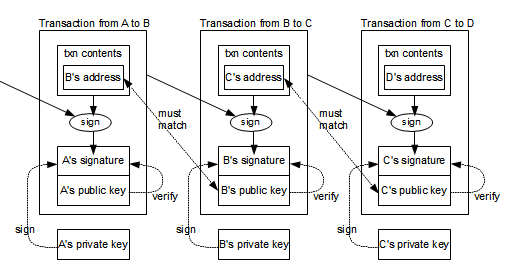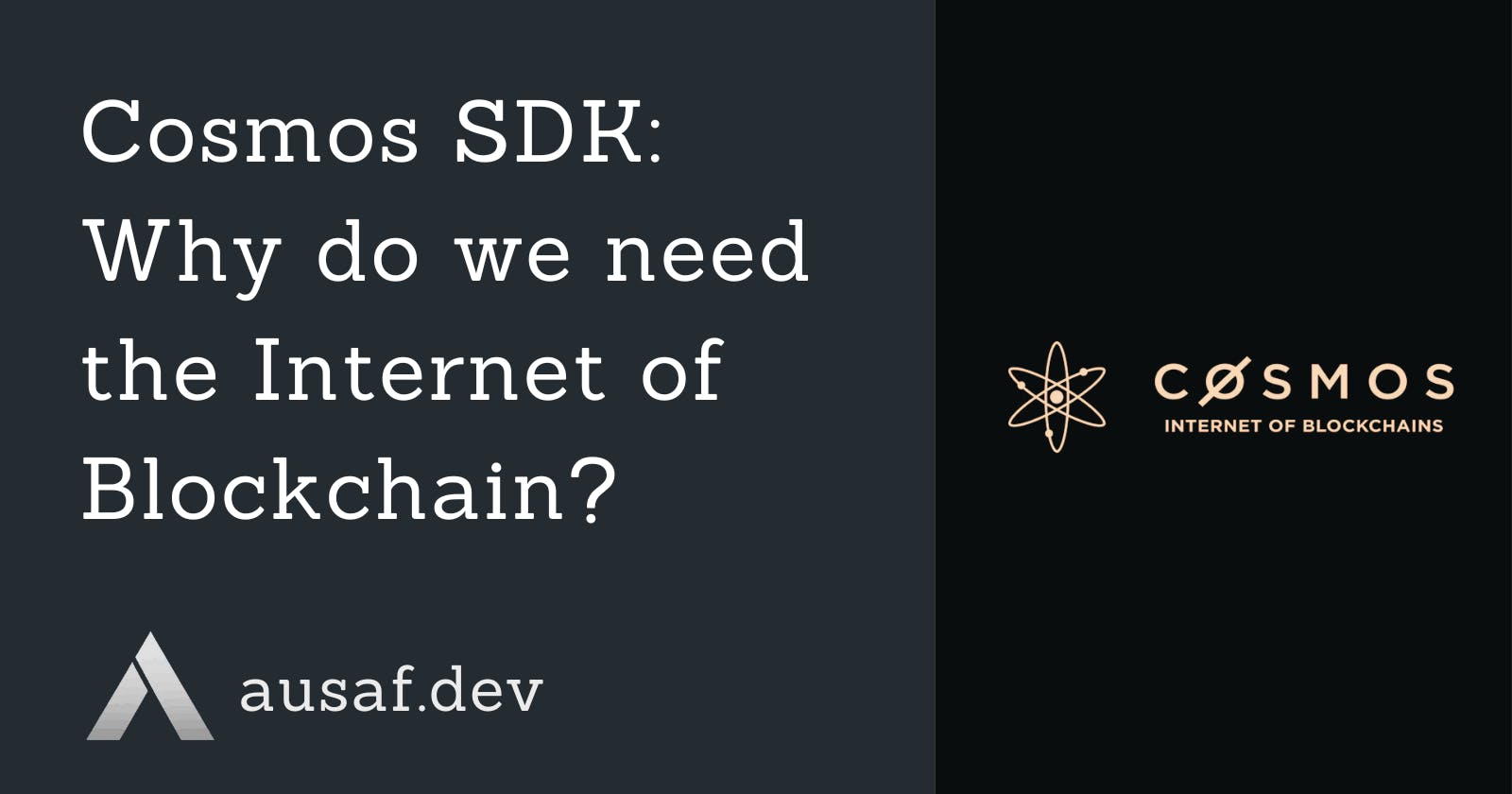Cosmos SDK: Why do we need the Internet of Blockchain?
A Brief History of Blockchain: From Store of Value to the Internet of Blockchain
We have come a long way from the primitive blockchain technology of 2009 developed by Satoshi Nakamoto, to the modern-day blockchain application development.
We can think of blockchain tech development in 3 phases or 3 generations. The first one, Bitcoin was developed essentially as a peer-to-peer internet cash, a decentralized store of value. The second one, Ethereum was developed as a decentralized and secure computer, which can run vastly more complex computations on-chain, and was a major milestone in blockchain tech. It still has issues with scalability, immutability, and interoperability, which we will soon look into. Lastly, we have the third generation of blockchains, that is Cosmos, and how it fixes the shortcomings of the previous technologies and provides a solid foundation for developers to quickly build and scaffold inter-operable blockchain applications.
So, let's dive deeper into this evolution of blockchain technology, starting with Bitcoin.
Bitcoin: The First Generation
Bitcoin, the first blockchain, is an open, decentralized ledger that records transactions between two parties in a permanent way without needing third-party authentication. This first-generation blockchain uses the Proof of Work (PoW) consensus algorithm, where miners compete to solve complex mathematical problems. The first to solve it gets to add a new block to the blockchain.
While Bitcoin introduced a trustless, peer-to-peer digital currency, it was limited in functionality. It's a single-purpose chain, primarily designed for transferring the Bitcoin currency, that is, as a store of value.
Bitcoin was the first major blockchain to popularize blockchain tech to the masses, with widespread real-world adoption and use cases. It was created as a reaction to the 2008 financial crisis, at a time when people's trust in traditional banks and financial institutions was at an all-time low. It could essentially act as a "non tamperable" ledger, meaning that the people's money could not be gambled away - and for the first time - there was no need to trust a centralized institution for securing assets/savings, and it was the first effective way to decentralize and commoditize trust.
Here's a technical overview of how Bitcoin block transactions work:
Let's visualize the signing and linkage of transactions using a streamlined illustration. Focusing on the intermediary transaction, which involves the transfer of bitcoins from address B to address C, we can understand the process. The particulars of this transaction, including the hash from the preceding transaction, are subjected to a hash function and subsequently signed with B's unique private key. The transaction also incorporates B's public key.

To authenticate the transaction as being initiated by B, a series of steps are executed. Firstly, a validation check is run to ensure that B's public key aligns with the address B from the prior transaction, confirming the public key's legitimacy. Following that, the signature B affixed to the transaction is cross-checked using B's public key incorporated in the transaction. These verifications solidify the transaction's validity and B's authorization. Interestingly, in the Bitcoin ecosystem, B's public key remains undisclosed until it becomes part of a transaction.
In this process, bitcoins traverse from one address to another, creating a chain of transactions. The integrity of each link in this chain can be confirmed, assuring that the bitcoins are being used legitimately. Remember that a transaction can generally have multiple inputs and outputs, causing the chain to diverge into a tree-like structure. Fundamentally, this is how all Bitcoin transactions are executed, and how all the new block formations take place.
With all the benefits this bought, it still has a lot of shortcomings. It doesn't support complex applications and struggles with issues like scalability and slow transaction speeds.
Ethereum: The Second Generation
Ethereum bought the second generation of blockchain by introducing the concept of "decentralized and trustless computing", which was the next major step after the decentralized and trustless store of value (ie, Bitcoin). This decentralized computer works with the help of smart contracts - self-executing contracts with the terms of the agreement directly written into code. Ethereum's blockchain runs the Ethereum Virtual Machine (EVM), which enables the deployment of these smart contracts and decentralized applications (DApps).
Initially, the Ethereum network operated on the same PoW consensus mechanism as Bitcoin, though it transitioned to a Proof of Stake (PoS) system in December 2022. This transition greatly helped in reducing energy consumption and made it more secure and scalable.
Ethereum's architecture consists of several key components:
Ethereum Accounts: Ethereum has two types of accounts: Externally Owned Accounts (EOAs), controlled by private keys, and Contract Accounts, controlled by their contract code. These accounts are essential for tracking the state (i.e., information) in Ethereum.
Ethereum State: The state in Ethereum is the collective information of all accounts and their current balance, contract code, and storage.
Transactions and Messages: Transactions are messages signed and initiated by EOAs, while messages are data passed between contract accounts. Both transactions and messages change the Ethereum state.
Smart Contracts: Smart contracts are account-holding objects on the Ethereum blockchain. They contain code functions and can interact with other contracts, make decisions, store data, and send Ether (the network's native cryptocurrency) to others.
Gas and Fees: Every operation in Ethereum requires a certain amount of computational work, measured in units of 'gas'. Gas ensures that resources on the network are used efficiently. Users pay for gas using Ether, and this cost is a transaction fee that incentivizes miners to include the transaction in the blockchain.
Consensus Algorithm: Ethereum initially used the same Proof of Work (PoW) consensus mechanism as Bitcoin, called Ethash. However, as stated before, Ethereum has transitioned to Proof of Stake (PoS) through Ethereum 2.0 upgrade for better scalability and energy efficiency.
Despite Ethereum's innovations, it still faces challenges, most notably, its inability to communicate with other blockchains, that is, the lack of interoperability, isolating Ethereum from the rest of the blockchain ecosystem. Further, despite the introduction of PoS, Ethereum continues to grapple with scalability issues and high transaction fees, limiting its potential for mass adoption. These challenges have opened the door for the emergence of third-generation blockchains like Cosmos, designed to solve the problem of interoperability while enhancing scalability and usability.
Cosmos: The Third Generation
Cosmos blockchain aims at fixing the problems faced by Ethereum, ie, interoperability, and scalability. Cosmos, unlike its predecessors, isn't a single blockchain but a network of blockchains, or "zones," connected through the Cosmos Hub. Each zone is an independent blockchain that can communicate with others through a revolutionary protocol known as Inter-Blockchain Communication (IBC).
IBC allows blockchains to exchange data and tokens with each other, creating an interconnected ecosystem of blockchains – the Internet of Blockchains. It essentially makes Cosmos a blockchain of blockchains, where each blockchain can maintain its consensus mechanism, security, and governance.
A crucial component of the Cosmos network is the Tendermint Core, which powers the consensus and networking of each blockchain in the Cosmos ecosystem. Let's delve deeper into the role and features of Tendermint.
Tendermint is a software implementation that provides a high-performance, consistent, and secure consensus engine, which forms the underlying technology of Cosmos. It packages the networking and consensus layers of a blockchain into a generic engine, allowing developers to focus on application development as opposed to the complex underlying protocol.
The features of Tendermint Core can be broken down as follows:
Byzantine Fault Tolerance (BFT) Consensus Algorithm: Tendermint uses a BFT consensus algorithm. This means the network can continue to function even if some of the validators – up to one-third – are failing or acting maliciously. In simple terms, even if a portion of the network goes offline or is compromised, the rest of the network can reach a consensus and continue to operate.
Block Finality: In contrast to Bitcoin's PoW algorithm where a transaction can be reversed due to forks in the network, Tendermint provides instant finality. This means that once transactions are confirmed, they are final. Forks are extremely unlikely due to the nature of the BFT consensus algorithm.
Validator Set: In Tendermint consensus, there is a known, fixed set of validators. Validators are responsible for committing new blocks in the blockchain. The right to propose the next block is initially assigned to one of the validators, after which others vote on it. If a block receives more than two-thirds of the votes, it is committed to the blockchain.
Application Blockchain Interface (ABCI): Tendermint is language-agnostic, meaning that developers can build applications in any programming language. This is made possible by ABCI, which allows the consensus and networking part of the software (Tendermint) to be decoupled from the application layer.
High Performance: Tendermint can handle up to thousands of transactions per second (depending on the nature of the application built on top of it), and under optimal conditions, can have a block time as low as 1 second.
In the context of Cosmos, each blockchain zone built with the Cosmos SDK is powered by Tendermint Core and retains its consensus mechanism, security, and governance. Also, a blockchain built with Cosmos follows a modular architecture. This design allows developers to choose from a variety of modules to implement specific functionalities, such as staking, governance, and token transfers.
A typical blockchain application built using the Cosmos SDK might follow this architecture:
Base Layer/Networking Layer: This layer consists of the basic blockchain framework provided by the Cosmos SDK, which includes the core logic for networking and consensus protocol.
Middleware Layer: The middleware layer is composed of various modules offered by the Cosmos SDK, which provide functionality for various features such as staking, governance, and inter-blockchain communication.
Application Layer: This is where custom logic resides. Developers can build and implement their own modules at this layer to provide the application-specific functionality they need.
In this architecture, Tendermint Core and Cosmos SDK work together. Tendermint Core handles the networking and consensus parts of the protocol, while the Cosmos SDK defines the application layer – the state machine and its transition logic.
The Cosmos SDK also allows developers to create their own tokens, which can be transferred directly from one Cosmos SDK chain to another without the need for peg zones or intermediaries, thanks to the IBC protocol.
In summary, the Cosmos network's capacity to foster an ecosystem of interoperable blockchains marks a significant evolution in blockchain technology. By enhancing scalability and enabling the sharing of data and tokens across blockchains, Cosmos ushers us into the era of the Internet of Blockchains – a crucial step towards the full realization of blockchain's potential.



